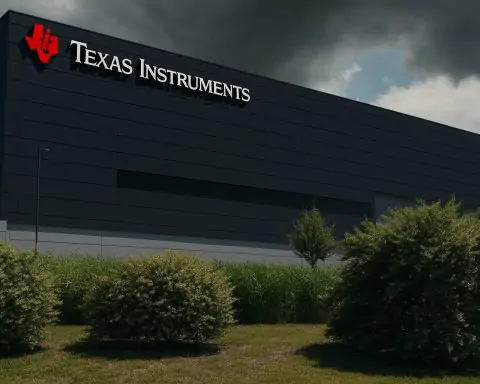Tokyo Electric Power Company Holdings, Incorporated (TEPCO, TSE: 9501) is back in the spotlight today as its share price rebounds from yesterday’s steep sell‑off, while investors digest two major themes: progress toward restarting the world’s largest nuclear power plant and fresh government‑backed funding for Fukushima compensation.
TEPCO share price today: rebound after a brutal slide
On Wednesday, 26 November 2025, TEPCO’s Tokyo‑listed shares closed at ¥790.8, up about 3.3% from Tuesday’s close of ¥765.5. Intraday, the stock traded between ¥775.7 and ¥803.1, with around 25.2 million shares changing hands. [1]
That bounce follows a highly volatile session on Tuesday, when TEPCO plunged 6.4%, swinging between ¥730.2 and ¥832.5 on heavy volume of roughly 183 million shares, almost double its recent average. [2]
Despite today’s recovery, the stock is still well below its mid‑November high near ¥939.4, and trades within a 52‑week range of ¥360–¥939.4. [3]
For international investors, TEPCO’s U.S. over‑the‑counter ADR (TKECY) was recently quoted around $4.92, down from a previous close of $5.19, with a 52‑week range of roughly $2.26–$5.80. [4]
Fast facts – TEPCO stock (TSE: 9501) as of Nov. 26, 2025
- Last close: ¥790.8
- Day change: +3.31% vs Tuesday
- Day range: ¥775.7–¥803.1
- Previous close (Nov. 25): ¥765.5
- 52‑week range: ¥360.0–¥939.4
- Approx. market cap (Nov. 25 close): ~¥1.23 trillion [5]
Today’s key news driving TEPCO shares
Several fresh developments around nuclear policy and Fukushima‑related funding are shaping sentiment on TEPCO stock this week.
1. New ¥10.9 billion NDF grant for Fukushima compensation
On 25 November 2025, TEPCO announced it has received a ¥10.9 billion grant from the Nuclear Damage Compensation and Decommissioning Facilitation Corporation (NDF). [6]
According to the company’s timely disclosure, this latest grant is part of a long‑running framework under which NDF provides financial assistance to cover nuclear damage compensation linked to the 2011 Fukushima Daiichi accident. TEPCO notes that: [7]
- It has previously received around ¥188.9 billion as indemnity payments and roughly ¥11.44 trillion in grants from NDF.
- The new funding request was the 163rd such application, reflecting that compensation payouts expected by the end of December 2025 were set to exceed the total assistance already granted.
A MarketScreener news summary and a TipRanks note both highlight the NDF grant as part of ongoing state support, helping TEPCO continue meeting obligations to affected residents and businesses while it pursues long‑term business recovery. [8]
For investors, the message is mixed: the grant underscores how large the Fukushima liabilities remain, but also shows that the Japanese government continues to underpin TEPCO’s compensation framework.
2. Niigata governor backs restart of Kashiwazaki‑Kariwa 6 and 7
The biggest structural catalyst for TEPCO remains the planned restart of the Kashiwazaki‑Kariwa nuclear power plant in Niigata Prefecture – the world’s largest nuclear facility.
On 21 November 2025, Niigata Governor Hideyo Hanazumi formally announced that he will consent to the restart of Units 6 and 7 (both 1,356 MWe ABWR reactors), subject to conditions and a consultation with the prefectural assembly in December. [9]
Key points from the governor’s stance and subsequent reporting:
- Hanazumi’s approval removes the last major political hurdle for TEPCO to move ahead with restarting the plant, after the reactors passed national safety examinations. [10]
- TEPCO plans to prioritize Unit 6, into which fuel was loaded earlier this year; it would be TEPCO’s first reactor restart since Fukushima Daiichi. [11]
- The governor issued seven detailed requests to the national government, including better safety communication with residents, renewed safety checks if new technical findings emerge, stronger national involvement in emergency planning, faster development of evacuation routes and shelters (including for heavy snow), clearer responsibility for spent‑fuel disposal and compensation frameworks, and measures to restore TEPCO’s credibility. [12]
- TEPCO has pledged to contribute about ¥100 billion over a decade to Niigata Prefecture from plant revenues and to make further investments that support local industry and jobs. [13]
A Jiji Press report notes that TEPCO itself estimates a roughly ¥100 billion annual boost to profitability if Kashiwazaki‑Kariwa is brought back online – a meaningful figure for a company posting massive losses. [14]
However, the restart is not yet a done deal: the Niigata Prefectural Assembly still needs to debate and effectively endorse the governor’s decision, and technical as well as community‑relations work continues.
3. Security concerns at the same plant still loom
Just a day before the governor’s announcement, Japan’s Nuclear Regulation Authority (NRA) disclosed that confidential nuclear security documents had been mishandled at Kashiwazaki‑Kariwa. [15]
According to the NRA:
- A TEPCO employee copied sensitive documents related to nuclear material protection without following required procedures and stored them at his desk.
- In separate incidents, confidential materials were mistakenly handed to a subcontractor, and unauthorized tools were brought into the plant.
- No evidence of information leaking outside the company has been found so far, but inspections are ongoing. [16]
The episode recalls earlier regulatory sanctions against TEPCO over security shortcomings at Kashiwazaki‑Kariwa and feeds into the governor’s demand for restoring public trust in the utility. Even though Japanese media suggest the issues are unlikely to derail the restart inspection schedule, they reinforce the perception that TEPCO’s governance and safety culture remain under intense scrutiny. [17]
4. Business uncertainty even with a restart
A separate analysis from Jiji Press, carried by Nippon.com on 25 November, captures the mixed outlook: TEPCO’s restart plan has “made a major step forward,” but it is still unclear if the company can stabilize earnings in the long run. [18]
The article highlights that:
- TEPCO expects a ¥100 billion annual profit uplift from the restart, but
- The company continues to face potentially rising costs for Fukushima decommissioning and compensation, and
- All seven reactors at Kashiwazaki‑Kariwa have been offline since 2012, forcing TEPCO to rely heavily on liquefied natural gas and coal for power generation. [19]
That tension between earnings upside from nuclear restarts and long‑dated nuclear liabilities is central to how the market prices TEPCO stock.
5. Nuclear restarts and Japan’s broader energy policy
Beyond TEPCO, Japan’s nuclear strategy is shifting. A piece in Japan Forward this week describes how the restart of TEPCO’s Kashiwazaki‑Kariwa plant marks a turning point for national energy policy. [20]
Key context:
- Electricity demand is rising again, driven by energy‑hungry AI data centers and new semiconductor facilities. [21]
- The government now aims to maximize nuclear power as a stable, carbon‑free source, after years of minimizing reliance following the 2011 accident. [22]
- Under the new Strategic Energy Plan, nuclear is targeted to supply about 20% of Japan’s power mix by fiscal 2040, roughly double its current share. [23]
For TEPCO, which serves the Tokyo metropolitan area, this policy shift is supportive – but contingent on regaining regulatory and public trust.
6. New integrated and human‑capital reports
On 20 November 2025, TEPCO published its Integrated Report 2025 and its first Human Capital Report 2025. [24]
According to the company:
- The integrated report is framed around four “materiality” themes:
- Revitalization and decommissioning (including Fukushima),
- Green transformation (GX) for sustainability,
- Reforming into a trusted nuclear power utility, and
- Strengthening the business foundation. [25]
- The human‑capital report details initiatives around governance, strategy, risk management, and metrics related to TEPCO’s workforce, aligning with new sustainability disclosure standards in Japan. [26]
These publications are part of TEPCO’s effort to show investors and regulators that it is investing in culture, human capital, and transparency – all critical if it wants to justify restarting reactors and, eventually, resuming shareholder returns.
Fundamentals: huge losses, heavy support, deep discount
TEPCO’s share price is being driven by policy and politics, but the fundamentals behind the story remain stark.
Largest first‑half loss since Fukushima
For the six months to September 30, 2025, TEPCO reported a net loss of about ¥712.4 billion, its largest first‑half loss since it shifted to consolidated accounting in fiscal 2020. [27]
Reuters reports that management attributes the loss mainly to higher costs linked to Fukushima compensation and disaster recovery, even as rivals like Kansai Electric boost profit guidance on strong demand. TEPCO’s representative executive vice president Hiroyuki Yamaguchi said the company aims to restore positive cash flow by restarting Kashiwazaki‑Kariwa Unit 6 and cutting costs, but offered no firm timeline. [28]
Valuation: low multiples, but for a reason
Independent analysis from Simply Wall St notes that, despite these headline losses, TEPCO’s shares had surged more than 60% year‑to‑date by early November and about 170% over five years, reflecting renewed optimism about nuclear restarts. [29]
Even after that run, they estimate:
- A price‑to‑sales ratio of about 0.2x, versus around 0.4x for peers and 1.1x for Asian electric utilities on average – implying a deep discount to the sector. [30]
On the book‑value side, FinanceCharts data show TEPCO’s ADR (TKECY) trading at a price‑to‑book ratio of roughly 0.45 as of 24 November 2025, up from a 12‑month average of 0.34 but still well below 1.0. [31]
Such depressed multiples are typical of companies with large, uncertain liabilities. TEPCO’s dependence on NDF funding – more than ¥11.4 trillion in cumulative grants so far – underlines how much Fukushima‑related costs still weigh on its balance sheet. [32]
Technical picture: recent downgrades after volatility
Technically focused site StockInvest.us flagged TEPCO as a “Strong Sell candidate” after Tuesday’s 6.4% drop, citing a string of recent declines, high volatility (a 14% intraday swing on Nov. 25), and the stock sitting near the lower end of its short‑term rising trend. [33]
Their models describe the shares as “high risk” day‑to‑day and see nearby resistance around ¥796–¥849, with support near ¥749, though they still project an 18% potential gain over the next three months if the broader uptrend resumes. [34]
These are third‑party technical views rather than guarantees; short‑term trading outcomes can diverge sharply from any model.
How TEPCO fits into Japan’s nuclear comeback
A series of articles and official comments this month frame TEPCO as central to Japan’s broader nuclear reboot: [35]
- Energy security & costs: Restarting large baseload reactors like Kashiwazaki‑Kariwa is seen as a way to cut dependence on imported LNG and coal, which still supply around 60–70% of Japan’s electricity.
- Decarbonization: Nuclear restarts are also part of Japan’s path toward climate targets and an expanded role for carbon‑free baseload power.
- Regional economy: TEPCO has promised sizeable financial contributions and local investment in Niigata if the plant restarts, aiming to demonstrate that benefits flow back to the host community. [36]
For TEPCO shareholders, these macro trends offer a potential long‑term upside – but only if the company can convincingly manage safety, governance, and compensation issues.
Key risks investors are watching
Anyone following TEPCO stock right now is tracking a cluster of intertwined risks:
- Regulatory and political risk
- The Niigata assembly’s December debate on the restart, and any future NRA findings, could accelerate or delay Kashiwazaki‑Kariwa’s return. [37]
- Fukushima compensation and decommissioning costs
- The latest NDF grant and TEPCO’s huge first‑half loss show that disaster‑related costs remain large and somewhat open‑ended. [38]
- Corporate governance and public trust
- Document‑handling lapses at Kashiwazaki‑Kariwa and the governor’s insistence on “restoring TEPCO’s credibility” highlight how reputational issues can affect operational approvals. [39]
- Market volatility
- With 10–14% daily trading ranges reported in recent sessions, TEPCO shares are behaving more like a high‑beta cyclical than a typical regulated utility, which can amplify both gains and losses. [40]
- No dividend since 2011
- Historical data show that TEPCO has not paid a dividend since before the Fukushima disaster, and there is no clear timeline for resumption, which may limit appeal for income‑focused investors. [41]
What to watch next for TEPCO stock
Looking ahead from today’s close on 26 November 2025, several near‑term milestones could move Tokyo Electric Power Company Holdings shares:
- December 2025: Debate and vote in the Niigata Prefectural Assembly on Governor Hanazumi’s restart decision. [42]
- Further NRA updates on security management and safety at Kashiwazaki‑Kariwa. [43]
- Ongoing NDF funding decisions and any revisions to Fukushima cost estimates. [44]
- Next earnings release, currently scheduled for late January 2026, where investors will look for updated guidance on cash flow and the nuclear restart schedule. [45]
For now, TEPCO remains a highly event‑driven utility stock: today’s rebound reflects optimism around nuclear restarts and government support, but the path ahead is likely to stay volatile as safety, policy, and financial questions are gradually resolved.
References
1. www.investing.com, 2. finance.yahoo.com, 3. www.investing.com, 4. www.investing.com, 5. www.investing.com, 6. www.tepco.co.jp, 7. www.tepco.co.jp, 8. au.marketscreener.com, 9. www.reuters.com, 10. www.reuters.com, 11. www.ans.org, 12. www.jaif.or.jp, 13. www.ans.org, 14. www.nippon.com, 15. www.reuters.com, 16. www.reuters.com, 17. www.reuters.com, 18. www.nippon.com, 19. www.nippon.com, 20. japan-forward.com, 21. japan-forward.com, 22. japan-forward.com, 23. japan-forward.com, 24. www.tepco.co.jp, 25. www.tepco.co.jp, 26. www.tepco.co.jp, 27. www.reuters.com, 28. www.reuters.com, 29. simplywall.st, 30. simplywall.st, 31. www.financecharts.com, 32. www.tepco.co.jp, 33. stockinvest.us, 34. stockinvest.us, 35. japan-forward.com, 36. www.ans.org, 37. www.jaif.or.jp, 38. www.tepco.co.jp, 39. www.reuters.com, 40. stockinvest.us, 41. stockinvest.us, 42. www.jaif.or.jp, 43. www.reuters.com, 44. www.tepco.co.jp, 45. stockinvest.us










